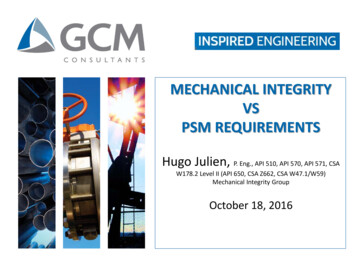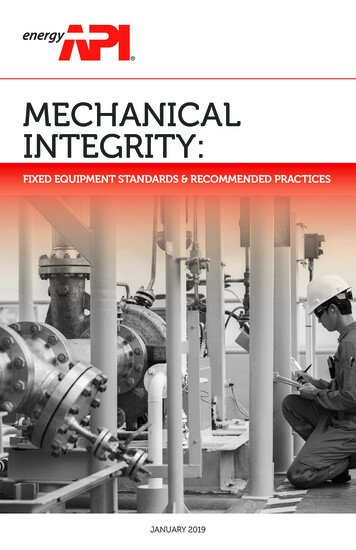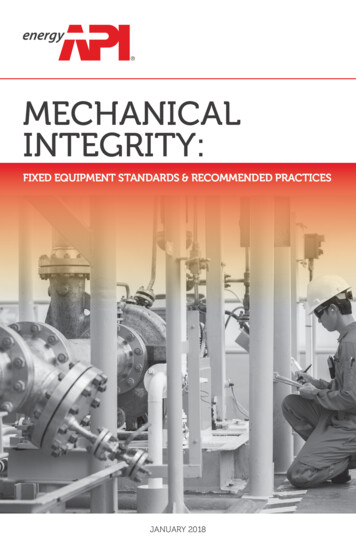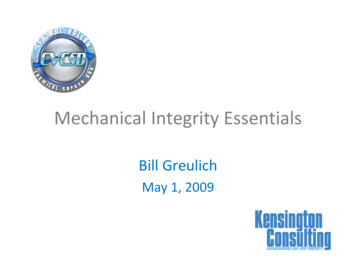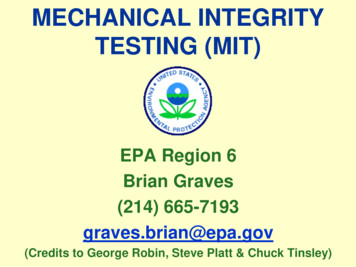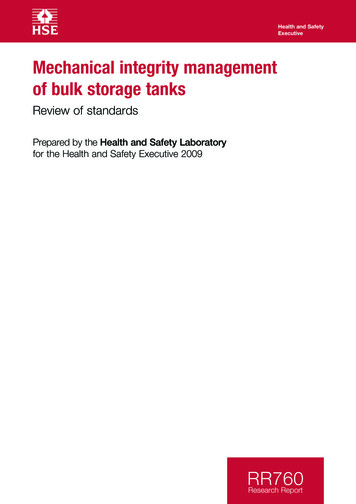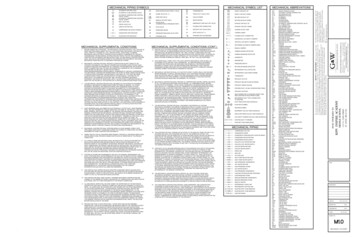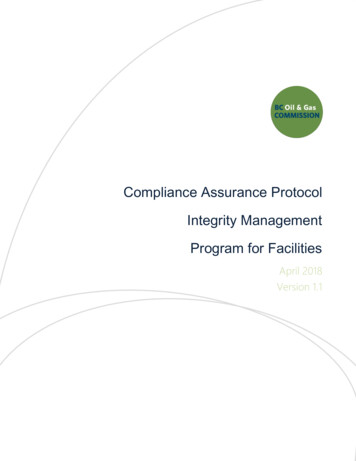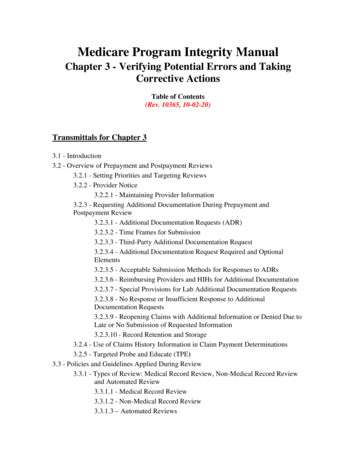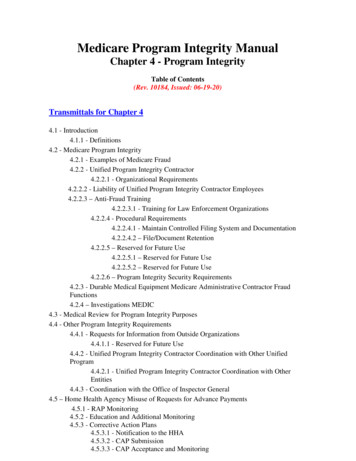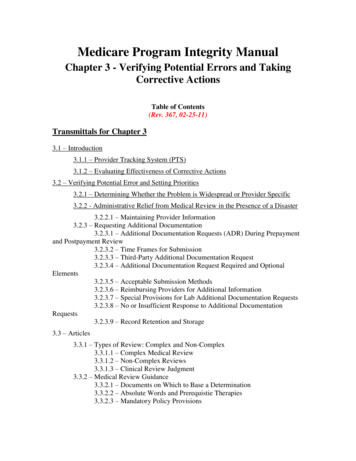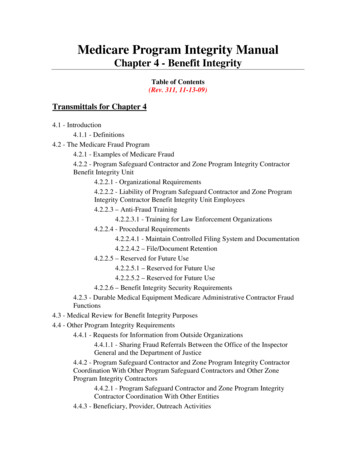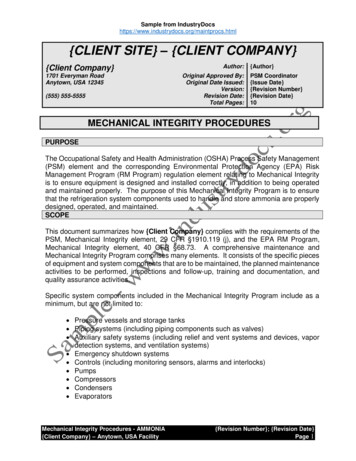
Transcription
Sample from s.html{CLIENT SITE} – {CLIENT COMPANY}{Client Company}1701 Everyman RoadAnytown, USA 12345(555) 555-5555Author:Original Approved By:Original Date Issued:Version:Revision Date:Total Pages:{Author}PSM Coordinator{Issue Date}{Revision Number}{Revision Date}10MECHANICAL INTEGRITY PROCEDURESPURPOSEThe Occupational Safety and Health Administration (OSHA) Process Safety Management(PSM) element and the corresponding Environmental Protection Agency (EPA) RiskManagement Program (RM Program) regulation element relating to Mechanical Integrityis to ensure equipment is designed and installed correctly, in addition to being operatedand maintained properly. The purpose of this Mechanical Integrity Program is to ensurethat the refrigeration system components used to handle and store ammonia are properlydesigned, operated, and maintained.SCOPEThis document summarizes how {Client Company} complies with the requirements of thePSM, Mechanical Integrity element, 29 CFR §1910.119 (j), and the EPA RM Program,Mechanical Integrity element, 40 CFR §68.73. A comprehensive maintenance andMechanical Integrity Program comprises many elements. It consists of the specific piecesof equipment and system components that are to be maintained, the planned maintenanceactivities to be performed, inspections and follow-up, training and documentation, andquality assurance activities.Specific system components included in the Mechanical Integrity Program include as aminimum, but are not limited to: Pressure vessels and storage tanks Piping systems (including piping components such as valves) Auxiliary safety systems (including relief and vent systems and devices, vapordetection systems, and ventilation systems) Emergency shutdown systems Controls (including monitoring sensors, alarms and interlocks) Pumps Compressors Condensers EvaporatorsMechanical Integrity Procedures - AMMONIA{Client Company} – Anytown, USA Facility{Revision Number}; {Revision Date}Page 1
Sample from procs.htmlSCOPE (continued){Client Company} utilizes the services of outside experts, as needed, for testing,inspection, and preventative maintenance purposes for which they elect to not handleinternally. {Client Company’s} refrigeration technicians perform all testing, inspectionsand maintenance activities not assigned to outside experts.REFERENCESA) OSHA 29 CFR §1910.119, Process Safety Management of Highly HazardousChemicals, Paragraph (j).B) OSHA Instruction CPL 2-2.45A, Process Safety Management of Highly HazardousChemicals-Compliance Guidelines and Enforcement Procedures, Sept. 13, 1994.C) IIAR Bulletin #109, Minimum Safety Criteria for a Safe Ammonia Refrigeration System.D) IIAR Bulletin #110, Guidelines for: Start-up, Inspection and Maintenance of AmmoniaMechanical Refrigerating Systems.E) RETA Industrial Refrigeration Course III - Plant Maintenance.F) RETA Industrial Refrigeration Course IV - Plant Operations and Safety.IMPLEMENTATION OVERVIEWFor the most part, the PSM Program is a subset of the EPA RM Program regulationrequirements. Recognizing this for the mechanical integrity requirements, and forimproved implementation and program maintenance efficiency, this document has beenimplemented which combines both the PSM and EPA RM Program requirements. Theoverall compliance program is referred to as the “Process Risk Management Program”.Equipment maintenance activities and record tracking are incorporated in a ComputerizedMaintenance Management System (CMMS). The software currently being used is a PCbased system - {CMMS NAME}. Refer to program documentation for complete details onmaintenance schedules and records.The main functions of the {CMMS NAME} software include: maintenance, inspection, and testing scheduling equipment lists/inventory maintenance procedures work order control database and inquiry system for maintenance record storage and retrievalMechanical Integrity Procedures - AMMONIA{Client Company} – Anytown, USA Facility{Revision Number}; {Revision Date}Page 2
Sample from procs.htmlIMPLEMENTATION OVERVIEW (continued)The CMMS and all maintenance activities are the responsibility of the Facilities Manager.Refer to the program documentation for detailed information on the software. Databaseinformation and maintenance records can be generated as needed.PROCEDURES{Client Company’s} Mechanical Integrity Program is composed of written procedures foreach of the elements of the program, including:1.2.3.4.Equipment InventoryInspection and Testing ProgramTraining for Process Maintenance ActivitiesQuality Assurance1.0EQUIPMENT INVENTORY1.1All major pieces of ammonia refrigeration system equipment are inventoried. Theinventory information is summarized in an equipment list generated by the CMMSthat provides technical information and key equipment specifications for testingand maintenance scheduling for each piece or type of equipment. All of theinformation on the equipment lists is consistent with information found in theindividual record file of each component and/or from the equipmentmanufacturer’s reference manuals. Equipment lists are modified as equipmentinventory information changes.1.2Record files for all equipment lists and documentation relating to specificcomponents, which typically include instruction manuals, warranty records, spareparts lists, inspection and repair records, and any other relevant information aremaintained for each specific component. These files are also referenced as thelocation where all inspection and testing forms and records from Section 2.0below are maintained. In most cases, the majority of the instruction manuals andrelated manufacturer’s information are grouped together in a few, large bindersoriginally supplied by the system installation contractor, and are not kept in theindividual component files. Refer to Form MI-1 for a list of available referencemanuals on the {Client Company’s} ammonia refrigeration system and relatedcomponents.2.0INSPECTION AND TESTING2.1For each piece of equipment or group of equipment, the following has beeninitially determined: the type of test or inspection to be performed;the frequency for each test and/or inspection; andMechanical Integrity Procedures - AMMONIA{Client Company} – Anytown, USA Facility{Revision Number}; {Revision Date}Page 3
Sample from procs.html the basis for the frequency (e.g. manufacturers’ recommendation,industry standard, equipment specific history, etc.).2.2The testing and maintenance schedule developed for Step 2.1 above iscommunicated to the refrigeration technicians by the Facilities Manager. TheFacilities Manager issues a job list for the refrigeration technicians detailing whatneeds to be done on what pieces of equipment and when generation of theseschedules is based on the CMMS.2.3Each system component or subsystem (e.g. compressor, pump, recirculator,liquid transfer system, etc.) included in the inventory has a maintenance,inspection and testing history log kept in the individual record file or in the CMMSon which all activities are recorded. This log includes the results of all inspectionsand tests, and a description of all maintenance activities performed.2.4The maintenance, inspection, and testing history log contain informationdocumenting each inspection and test that has been performed on a piece ofequipment. The required information included on the form is: the date of the inspection or test;the name of the person who performed the inspection or test;the serial number of the other identifier of the equipment that is beinginspected or tested;a description of the inspection or test performed; andthe results of the inspection or test.2.5Information concerning type of test or inspection for specific pieces of equipmentcan be found in the vendor or manufacturer’s recommendations. Refer to theequipment list provided by the CMMS or the manufacturer’s equipment referencemanual. Form MI-1 is a list of available reference manuals on the ammoniarefrigeration system and related components.2.6Any equipment deficiencies found during any inspections which are outsideacceptable limits are corrected before further use, or in a safe and timely manner,when necessary means are taken to assure safe interim operation. Records ofsuch deficiencies, when they are found and when they are corrected, areprepared and kept in the individual record file.2.7Personnel involved in the testing and inspection of systems covered by ProcessSafety Management are trained and/or certified to perform testing in accordancewith established site or applicable industry standards.When inspection and testing is performed by a contractor or a third party vendor,documentation of the procedure and copies of personnel qualification records willbe included in the final report or be part of the contract employee training records.The PSM Coordinator will keep this information on file.Mechanical Integrity Procedures - AMMONIA{Client Company} – Anytown, USA Facility{Revision Number}; {Revision Date}Page 4
Sample from procs.html3.0TRAINING FOR PROCESS MAINTENANCE ACTIVITIES3.1{Client Company} trains those employees involved in maintaining the on-goingintegrity of the process equipment in the following areas: an overview of the process and its hazards.the procedures applicable to the employee’s job tasks.formal training classes.departmental or shop safety meetings.{Client Company} verifies that the employee can perform the job tasks in a safemanner.3.2New refrigeration operating engineers are trained prior to beginning work at thesite, and all receive additional training as appropriate for their currentassignments. Training information is maintained in the employee’s personnel fileand in the PSM Coordinators’ office.3.3All refrigeration-operating engineers are trained in {Client Company’s} SafeWork Practices prior to starting work at the site (i.e. Hot Work, Lockout/Tagout,etc.).3.4All refrigeration-operating engineers are provided with access to all writtenMaintenance Procedures and manufacturer’s equipment manuals.4.0QUALITY ASSURANCE4.1The ammonia refrigeration systems at {Client Company} were designed by, andinstalled under the supervision of persons who by reason of knowledge, trainingand experience are competent for the tasks. Such persons include: 4.24.3Experienced refrigeration contractors, possibly in combination with anengineering code authority, authorized inspection agency or propertyinsurance underwriter In-house design/engineering/operations staff of the employer Consulting engineers, acting on behalf of the employer Refrigeration equipment supplier Refrigeration service vendorsIt is {Client Company’s} responsibility to ensure that the designers andcontractors responsible for the construction and modification of the ammoniarefrigeration system are qualified for their relevant responsibilities. {ClientCompany} follows the procedures outlined in the “Contractor Safety Procedures”guide when required. All documentation on contractors will be kept on file in thePSM Coordinators office.Equipment specifications shall be generated by {Client Company} or inconjunction with the qualified contractor/design group. The following shall besubmitted to the Facilities Manager and PSM coordinator for review/approval toMechanical Integrity Procedures - AMMONIA{Client Company} – Anytown, USA Facility{Revision Number}; {Revision Date}Page 5
Sample from procs.htmlensure equipment/facilities are installed properly and consistent with designspecifications and/or manufacturer’s instructions: design criteria operating conditions materials of construction fabrication standards inspections tests certifications (Form U-1A) equipment list equipment specifications valve list (location, drawing, size, type, manufacturer, model and connection) valve setup (equipment, valve positions – startup, normal, shutdown, etc.) material test reports all necessary Process Safety Information (PSI), see PSI procedureThis information will be kept on file in the PSM coordinators office.4.4Appropriate checks and inspections are performed to ensure that all ammoniarefrigeration system components, including contractor-supplied items, areinstalled properly and consistent with design specifications and themanufacturer’s instructions.4.5All essential records and documentation relevant to the ammonia refrigerationsystem obtained by {Client Company} are maintained by {Client Company} bythe PSM Coordinator, and are readily available to those concerned withinspection, maintenance and operation.{Client Company} ensures that all maintenance materials, spare parts, andammonia refrigeration system components, including contractor-supplied items,are suitable for the application for which they are used and that any substitutesare equally suitable for the application for which they may be used. See 4.3above.4.64.7All ammonia system repair requests are brought to the attention of the FacilitiesManager or immediate Supervisor and recorded in the refrigeration technician’slogbook. The Facilities Manager determines the urgency of the repair andschedules an appropriate time for the repair.FORMSThe following forms are suggested for use. These forms are not required as part of thisprocedure so long as similar forms or documentation are kept which provide at least theequivalent amount of information to comply with the requirements of this element. Reference Document List (Form MI-1)Equipment List – Appendix AMechanical Integrity Procedures - AMMONIA{Client Company} – Anytown, USA Facility{Revision Number}; {Revision Date}Page 6
Sample from procs.htmlMechanical Integrity Procedures - AMMON
(PSM) element and the corresponding Environmental Protection Agency (EPA) Risk Management Program (RM Program) regulation element relating to Mechanical Integrity is to ensure equipment is designed and installed correctly, in addition to being operated and maintained properly. The purpose of this Mechanical Integrity Program is to ensure
